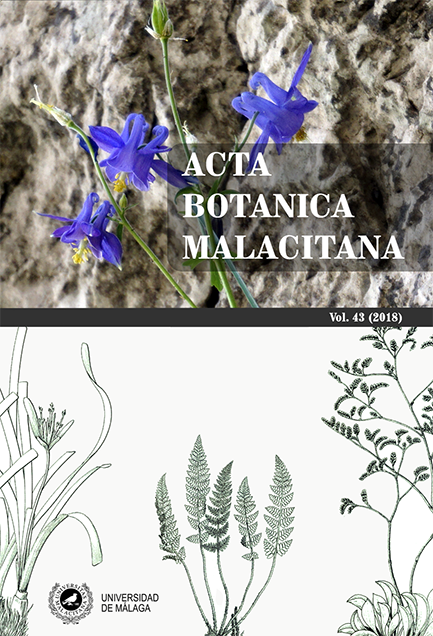Presencia de Cyperus papyrus L. (Cyperaceae) en la región biogeográfica atlántica de la Península Ibérica
DOI:
https://doi.org/10.24310/abm.v43i0.5011Abstract
Resumen: Nueva cita de una población de Cyperus papyrus L. naturalizada en Galicia, NO de España, amplía el rango biogeográfico de distribución de esta especie alóctona en la Península Ibérica.
Palabras clave: especie alóctona, Cyperus papyrus, ecología, distribución, interés cultural, Península Ibérica.
A new record of Cyperus papyrus L. confirm the presence of naturalized populations in the Iberian Peninsula.
Summary: New record of a population of Cyperus papyrus L. naturalized in Galicia, NW of Spain, extends the biogeographic range of distribution of this non-indigenous species in the Iberian Peninsula.
Keywords: Non-indigenous species, Cyperus papyrus, ecology, distribution, cultural heritage, Iberian Peninsula
Downloads
Metrics
References
Allen, K.W. (1996). Papyrus some ancient problems in bonding. International Journal of Adhesion and Adhesives, 16(1), 47-51. doi: 10.1016/0143-7496(96)88486-7
Bartolucci, F., Peruzzi, L., Galasso, G., Albano, A., Alessandrini, A., Ardenghi, N.M.G., Astuti, G., Bacchetta, G., Ballelli, S., Banfi, E., et al. (2018). An updated checklist of the vascular flora native to Italy. Plant Biosystems, 152(2), 179-303. doi: 10.1080/11263504.2017.1419996
Beentje, H.J. (2017). Cyperus papyrus, Papyrus Sedge. The IUCN Red List of Threatened Species (fecha de consulta 10/09/2018). doi: 10.2305/IUCN.UK.2017-1. RLTS.T164158A66891399.en
Brullo, C., Minissale, P., Sciandrello, S. & Spampinato, G. (2011). Phytogeographic survey on the endemic vascular flora of the Hyblaean territory (SE Sicily, Italy). Acta Botanica Gallica, 158(4), 617-631. doi: 10.1080/12538078.2011.10516299)
Carballeira, A., Devesa, C., Rubén Retuerto, R., Santillán, E. & Ucieda, F. (1983). Bioclimatología de Galicia. A Coruña: Fundación Pedro Barrié de la Maza.
Castroviejo, S. (2006). Más sobre Cyperus y Kylinga en la Península Ibérica. Acta Botanica Malacitana, 31, 232–238. doi: 10.1080/00837792.2013.801110
Castroviejo, S. (2007). Cyperus. In S. Castroviejo, M. Luceño, A. Galán, P. Jiménez Mejías, F. Cabezas & L. Medina (Eds.). Flora iberica Vol. 18. Cyperaceae- Pontederiaceae (pp. 8-27), Madrid: Consejo Superior de Investigaciones Científicas.
Conti, F., Abbate, G., Alessandrini, A. & Blasi, C. (2005). An annotated checklist of the Italian vascular flora. Rome: Palombi Editori.
EUAP (2010). Elenco ufficiale delle aree protette, 6º Aggiornamento approvato il 27 aprile 2010 e pubblicato nel Supplemento ordinario n. 115 alla Gazzetta Ufficiale n. 125 del 31 maggio 2010 (fecha de consulta 10/09/2018). Roma: Ministero dell’Ambiente. http:// www.gazzettaufficiale.it.
Giardina, G., Raimondo, F.M. & Spadaro, V. (2007). A catalogue of plants growing in Sicily. Bocconea, 20, 5–582. doi: 10.1080/12538078.2011.10516299
Guinea, E. (1953). Geografía botánica de Santander. Santander: Imprenta Provincial de Santander, Diputación de Santander.
Jiménez-Mejías, P. & Luceño, M. (2011). Cyperaceae. In Euro+Med PlantBase. The information resource for Euro-Mediterranean plant diversity (fecha de consulta 10/09/2018). Berlin: Botanic Garden and Botanical Museum Berlin-Dahlem. http://ww2.bgbm. org/EuroPlusMed/query.asp.
Kipkemboi, J. & van Dam, A.A. (2016). Papyrus Wetlands. In C. Finlayson, G. Milton, R. Prentice & N. Davidson (Eds.), The Wetland Book (pp. 1-15). Dordrecht: Springer. doi: 10.1007/978-94-007-6173-5_218-1
Laínz, M. (1976). Aportaciones al conocimiento de la Flora Cántabro-Astur, XI. Boletín del Instituto de Estudios Asturianos, 22, 3-44.
Orti, G.G. (1834). Al barone Vincenzo Mortillaro diretore del Poligrafo e conservatore del museo pubblico di Verona, parte 2, XI. Giornale di Scienze lettere e arti per la Sicilia, 47, 316-326.
Peña, C., Sebastián, A. & Laguna, E. (2003). Cyperus papyrus L. en la Albufera de Valencia. Flora Montiberica, 23, 44–45.
Ramírez, P., Díaz Espinosa, A. & Díaz, J.E. (2012). Cyperus papyrus. In A.M. Díaz-Espinosa, J.E. Díaz- Triana & O. Vargas (Eds.), Catálogo de plantas invasoras de los humedales de Bogotá (pp. 106-111). Bogotá: Universidad Nacional de Colombia.
Royo Pla, F. (2006). Flora i vegetació de les planes i serres litorals compreses entre el riu Ebro i la serra d´Irta. Tesis doctoral. Barcelona: Universidad de Barcelona.
Sánchez Gullón, E., Verloove, F. & Silva, V. (2017). New records of interesting xenophytes in the Iberian Peninsula. VII. Folia Botanica Extremadurensis, 11, 39-50. doi: 10.5209/rev_LAZA.2015.v36.48752
Sanz-Elorza, M., Guillot-Ortiz, D. & Deltoro, V. (2011). La flora alóctona de la Comunidad Valenciana (España). Botanica Complutensis, 35, 97-130. doi: 10.5209/rev_ BOCM.2011.v35.10
Serag, M.S. (2003). Ecology and biomass production of Cyperus papyrus L. on the Nile bank at Damietta, Egypt. Journal of Mediterranean Ecology, 4(3-4), 15- 24.
Verloove, F. (2014). A conspectus of Cyperus s.l. (Cyperaceae) in Europe (incl. Azores, Madeira and Canary Islands), with emphasis on non-native naturalized species. Webbia, 69(2), 179-223. doi: 10.1080/00837792.2014.975013
Verloove, F. (2017). New xenophytes from the Canary Islands (Gran Canaria and Tenerife; Spain). Acta Botanica Croatica, 76 (2), 120–131. doi: 10.1515/ botcro-2017-0013
Vieira, S. (2002). Cyperus papyrus L. DAISIE European Invasive Alien Species Gateway (fecha de consulta 10/09/2018). http//www.europe-aliens.org/ speciesFactsheet.
Downloads
Published
How to Cite
Issue
Section
License
All information related to the licensing of published works in Acta Botanica Malacitana and copyright can be found in our Editorial Policy.







1.png)
